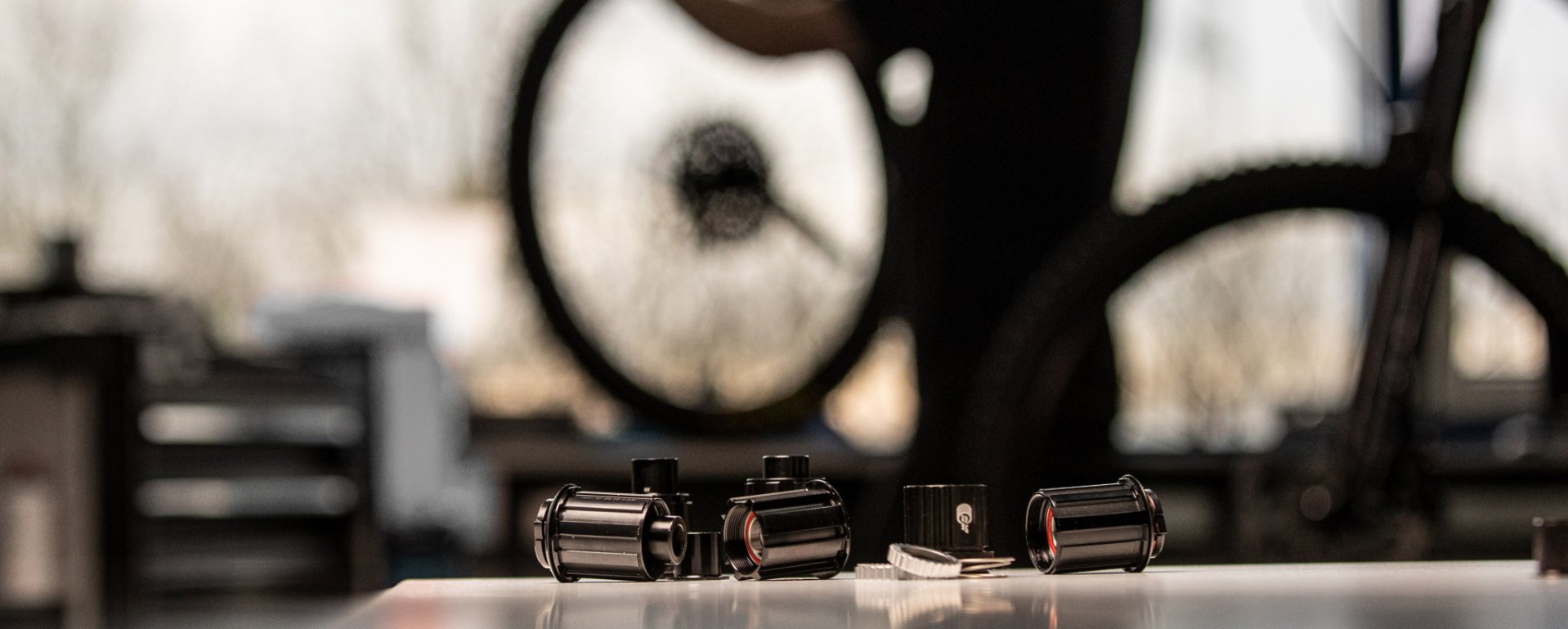
How To: Inspect Your Bike
Ready for the season? We’ll show you how to prepare your bike for the upcoming season and which parts require special attention.
How does the freehub on a bike work? What should you pay attention to when converting shifters &derailleurs, which freehub is compatible with which models?
Before you, the trail, behind you, a dust cloud, and in between, a soundtrack of tire noise, bird chirps, and the humming of your hub. Or more precisely: the freehub on your bike. It's your constant companion. It is the interface between the cassette and the rear wheel. When you pedal, it transmits the forces from the sprocket to the hub. When you lift your legs, it allows you to roll effortlessly. Some appreciate it for its unique sound – like a catchy tune. It can even replace the bike bell.
If you're retrofitting your shifting system, a swap of the freehub body might be necessary. If you're choosing a new rear hub or a new wheelset, the type of freehub is an important factor. In the following paragraphs, you'll learn what you should pay attention to when choosing and changing the freehub body. We provide an overview of which freehub is compatible with which shifting system and explain how the freehub on your bike works.
Even though choosing the right freehub is an important factor when buying a new bike, rear hub, or wheel system, during a conversion, upgrade, or tuning, the freehub body plays a central role. It makes a splined connection to the cassette, transmitting your leg power through the chain. There are various standards. So, if you want to tune or retrofit your drivetrain, you have to pay special attention to the freehub.
There are two important criteria for choosing. It must:
Most hub manufacturers offer conversion kits for the mounting standards of various cassette or drivetrain manufacturers. If you're upgrading your drivetrain within the same manufacturer's product range, say from a Shimano 10-speed to an 11-speed or from SRAM 11-speed to 12-speed, you often can avoid swapping the freehub body. However, the decisive factor is the compatibility of the desired cassette. That's why you can also filter all cassettes by "freehub compatibility" in our shop.
How exactly the conversion of the freehub body goes depends on the hub manufacturer. Many manufacturers like Hope, DT Swiss, SRAM, or Shimano allow for a tool-free conversion: the freehub body is simply plugged in. Whether this is the case with your hub or how a change is made instead, the operating instructions or our service team will tell you.
Some tools are required to remove the wheel beforehand and dismantle the cassette. How this works can be found in separate posts. How To: Change MTB cassette / How To: Change cassette on a road bike? Here’s how!
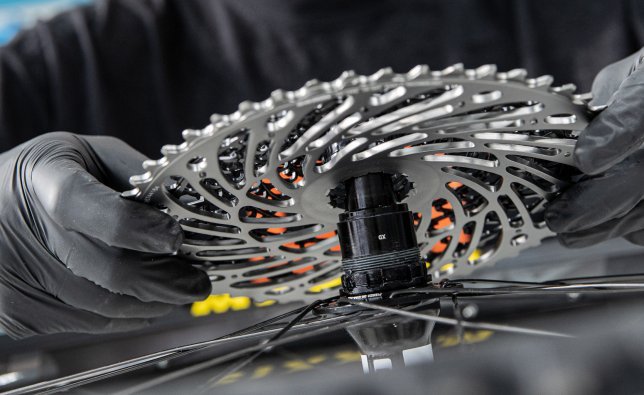
When converting, you must ensure that the freehub body and cassette fit together. © bc GmbH & Co. KG
To help you keep track when shopping, we've summarized the most common mounting standards and cassette compatibilities briefly. If you're looking for a quick overview, you can find it below.
The Shimano Hyperglide (HG) MTB standard is suitable for 8-, 9-, 10-, and 11-speed mountain bike cassettes from Shimano and various other manufacturers that have at least 11 teeth on the smallest sprocket (also SRAM, but not SRAM XD or XDR). The space for the cassette is 34.9 millimeters long and has 9 splines. Shimano also refers to the standard as "HG spline M".
Notice: 8-, 9-, and 10-speed road bike cassettes from Shimano also fit.
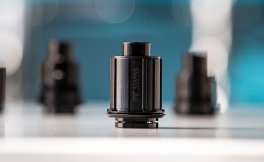
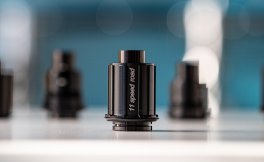
The Shimano Hyperglide (HG) Road standard is suitable for 8-, 9-, 10-, 11-, and 12-speed road bike cassettes from Shimano and various other manufacturers that have at least 11 teeth on the smallest sprocket (also SRAM, but not SRAM XD or XDR). The space for the cassette is 36.75 millimeters long and has 9 splines. You can mount 8- to 10-speed cassettes using a spacer. Shimano's designation is "HG spline L".
Notice: The 11-speed Road cassettes CS-HG800 and CS-HG700 also require a spacer.
Shimano’s 12-speed Dura-Ace rear hubs come with a unique freehub that’s shipped with Dura-Ace wheels. The 12-speed cassette fits into 18 notches that are 37.65 millimeters long. Shimano calls this freehub “HG spline L2”.
Heads up: This freehub is only compatible with 12-speed cassettes.
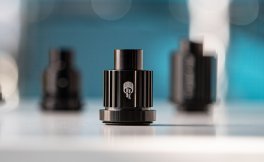
With the move to 12-speed MTB drivetrains, Shimano introduced the Micro-Spline standard. It allows for using a smallest sprocket with 10 teeth and works with 12-speed MTB cassettes from Shimano. The cassette fits onto 23 notches that are 26 millimeters long. Shimano licenses the use of Micro-Spline technology to other cassette or rear hub manufacturers.
Heads up: not usable with SRAM XD and XDR compatible cassettes.
The XD standard was introduced by SRAM alongside their 11-speed MTB drivetrains as an open standard to enable the use of cassettes with a smallest sprocket of 10 teeth or less (like e*thirteen with a 9-tooth sprocket). It’s compatible with 11- and 12-speed cassettes from SRAM and various third parties.
Heads up: not usable with Shimano-compatible cassettes (HG). Not usable with SRAM XDR cassettes (12-speed road).
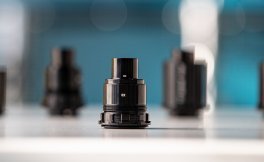
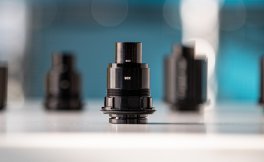
Unlike SRAM XD, the XDR standard features a 1.85-millimeter longer freehub body. It's designed for use with cassettes that have a smallest sprocket of 10 teeth or less and is compatible with SRAM road 12-speed cassettes. With the use of a 1.85-millimeter spacer, it's compatible with SRAM XD cassettes (see above).
Heads up: not usable with Shimano-compatible cassettes.
The Italian manufacturer Campagnolo uses a proprietary freehub standard with 8 differently shaped notches that the cassette fits onto. It accommodates cassettes from 9-, 10-, 11-, and 12-speed road groups.
Heads up: not usable with Shimano- or SRAM-compatible cassettes.
Since 2020, Campagnolo has introduced another freehub: N3W. The freehub body has the same tooth profile as the classic Campa freehub with 8 notches. However, N3W is shorter to make room for the smallest sprockets (9 and 10 teeth) of 13-speed cassettes. With an adapter, N3W is compatible with older Campagnolo cassettes.
Heads up: not usable with Shimano or SRAM compatible cassettes.
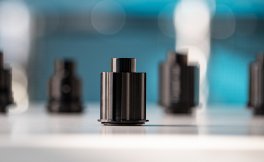
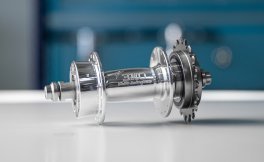
For singlespeed and trial bikes, there are special hubs with narrow freehub bodies that typically offer enough space to adjust the chain line with spacers. The narrow freehub allows for wider hub flanges, enabling the construction of symmetrical and stiffer wheels. However, it’s not possible to convert such hubs to a geared setup with a cassette later on. But you can convert freehub bodies for Shimano Road, MTB, and SRAM (not XD or XDR) to single-speed operation using the relevant spacers and single-speed sprockets. Some single-speed sprockets have a wider base to protect the freehub body.
Another variant is single-speed hubs with a screw thread. For this design, you need a sprocket with an integrated freewheel, i.e., a freewheel sprocket.
Track bikes and fixies don’t have any freehub at all. Here, the sprocket is screwed directly onto the hub body and secured with a lockring. When the rear wheel turns, the sprocket and crank turn as well.
Freehub bodies are available in various materials. Aluminum freehubs are very common. They are lightweight but can get notched from the torque of individual sprockets. That’s why nearly all sprockets on many cassettes sit on a carrier that spans the full width of the freehub. Steel freehubs are more durable but heavier. Super fancy hubs sometimes come with freehub bodies made of titanium, which combines low weight with robustness.
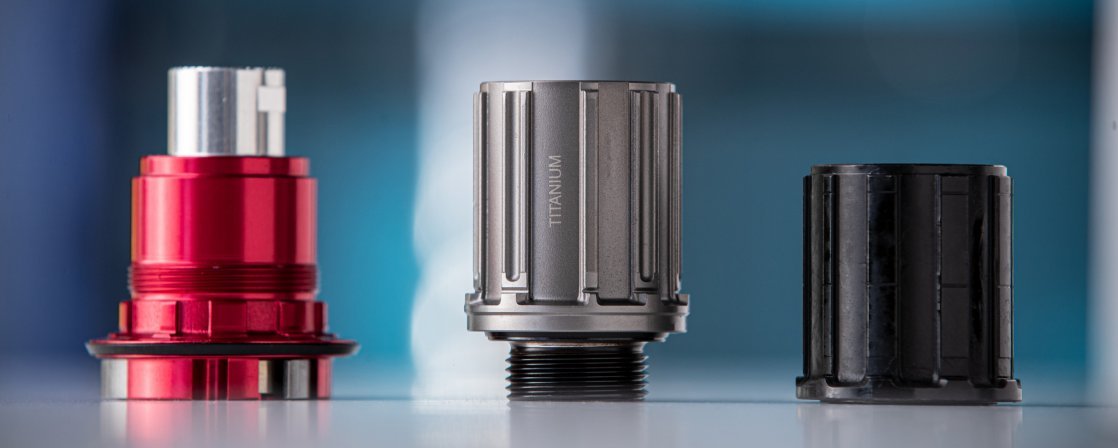
3 materials are used for the freehub body (from left to right): aluminium, titanium or steel. © bc GmbH
Free to spin in one direction and not the other – how does that work, actually? Most bike freehubs are designed either with what are called pawls or as a ratchet freehub.
A pawl freehub has several small pawls inside the hub that are pushed outwards by springs. A ratchet design on the hub body acts as the counterpart. When you pedal, the pawls firmly engage the teeth, moving the hub along. Since the pawls and the teeth only fit together in one direction, the hub can turn forwards even when the freehub body is stationary (when you’re coasting without pedaling). Then, the pawls glide over the teeth in the hub body – usually with a noticeable sound. There are different designs for how many pawls a freehub has and how many of them engage at the same time. Known examples of high-quality hubs with pawl freehubs include models from the English manufacturer Hope.
The second major design principle is the ratchet system freehub. Brands like DT Swiss and Chris King favor this design, promising low maintenance and mechanical durability. Here, during pedaling, two ratchet rings interlock, pressed together by springs. One is located in the hub body and the other in the freehub body. Unlike pawl freehubs, in ratchet systems, all teeth engage simultaneously. This creates a very large contact area, making the freehubs very robust even under high force. Here too, the teeth only mesh in one direction. In the opposite direction, the ratchet rings audibly slide over each other.
The finer the engagement of the ratchet or pawls, the more engagement points you have with each revolution of the hub. This reduces the engagement or release angle when pedaling. In other words: The dead spot on the crank decreases, and after coasting, you're almost immediately back in power transfer. This is especially important for trial, mountain, and gravel bikers. On a road or triathlon bike, where constant pedal rotation is sought, this is less crucial. Here, fewer, but larger, pawls can excel through higher robustness and resistance to your leg force.
The engagement system is also responsible for the sound you hear while coasting. The more engagement points your hub has, the higher the buzzing sound. How defined and loud your freehub sounds depends on the details of how the manufacturer has sized the ratchets or pawls – and on the lubrication. The cassette, rims, and even the frame can amplify the noise as a resonator. Thus, every bike has its unique road or trail soundtrack.
| Type of Freehub | Which cassettes fit the profile? | How many sprockets can the cassette have? | Spacer needed? |
| Shimano MTB (HG spline M) | Shimano, SRAM (except XD/XDR) and third-party (SunRace, OneUp Components, etc.) | 11-speed-MTB (plus CS-HG800 und CS-HG700) | No |
| Selected 10-speed Road: CS-7900 / CS-7800 / CS-6700 / CS-6600 / CS-5700 / CS-5600 | 1,85 + 1 mm | ||
| 8-/9-/10-speed (Road and MTB) | No | ||
| Shimano Road (HG spline L) | Shimano, SRAM (except XD/XDR) and third-party (Rotor, Miche, u. a.) | 12-speed-Road | No |
| 11-speed-Road (except CS-HG800 and CS-HG700) | No | ||
| 11-speed-MTB (plus CS-HG800 und CS-HG700) | 1,85 mm | ||
| Selected 10-speed Road: CS-7900 / CS-7800 / CS-6700 / CS-6600 / CS-5700 / CS-5600 | 1 mm | ||
| 8-/9-/10-speed (Road and MTB) | 1,85 mm | ||
| Shimano 12-speed | Shimano | 12-speed-Road | No |
| Shimano 12-speed Micro Spline | Shimano | 12-speed-MTB | No |
| SRAM XD | SRAM and third-party (e*thirteen, KCNC, u. a.) | 11-/12-speed (MTB) | No |
| SRAM XDR | SRAM | 12-speed (Road) | No |
| 11-/12-speed (MTB) | 1,85 mm | ||
| Campagnolo | Campagnolo Ultra-Drive | 9-/10-/11-/12-speed Ultra-Drive | No |
| Campagnolo N3W | Campagnolo N3W | 13-speed | N0 |
| 11-/12-speed | Adapter (Item No. 78166) |
